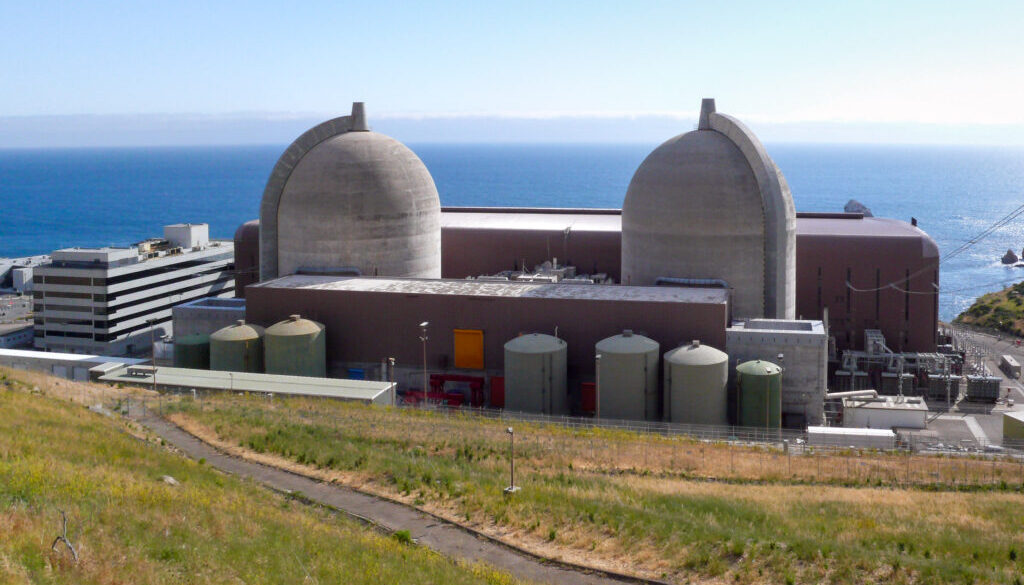Critical hearing looms in battle over California’s last nuclear power plant
Opponents of a nuclear power plant in California face a key court hearing next week, a potential turning point in a long-running battle over the fate of the controversial facility.
The environmental group Friends of the Earth (FOE) is set to square off against Pacific Gas & Electric Power Co. (PG&E) in an effort to keep alive the group’s legal challenge to PG&E’s continued operation of the Diablo Canyon nuclear power plant, which is located on the coast roughly halfway between Los Angeles and San Francisco.
FOE filed suit in April in San Francisco County Superior Court alleging that PG&E is violating an agreement it signed with the group in 2016 pledging to fully retire the plant – the last nuclear power plant in the state – by 2025. Now, with the support of state and federal officials, the utility is seeking approval from regulators to keep the plant running until 2045.
PG&E is asking the court to stay or dismiss the FOE lawsuit. Both sides will air their arguments on the issue Monday morning in San Francisco County Superior Court.
PG&E says the plant can “ensure the long-term availability of a valuable source of safe, clean, affordable and reliable electricity for more than three million Northern and Central Californians.”
In contrast, FOE, along with several scientists and environmental advocates, asserts the Diablo Canyon plant is a danger to public safety and the environment. Critics fear the plant’s continued operations put the state at risk of a nuclear accident, prevent state officials from fully embracing a transition to clean energy, and saddle the public with an unnecessary financial burden.
“Over 50 years ago, Friends of the Earth was founded to oppose Diablo Canyon and is continuing the fight to finally retire this dangerous power plant,” said Hallie Templeton, FOE legal director.
An uphill climb for critics
The controversy over the Diablo Canyon nuclear power plant is part of a broad, ongoing debate over whether the US should leverage nuclear power as part of a transition away from fossil fuels and toward more “clean” energy sources.
But critics face an uphill climb in challenging the extension of Diablo Canyon operations. A state law passed last summer allows the plant to keep running through October 2030 as PG&E seeks a 20-year license extension.
California Gov. Gavin Newsom has said he supports a “limited-term extension” for the power plant, citing a need to “support reliability statewide and provide an onramp for more clean energy projects to come online.” California has struggled to meet power demands across the state in recent years.
And last year the Biden administration announced it would give PG&E a $1.1 billion grant to help keep the plant open.
A 2021 report by researchers at the Massachusetts Institute of Technology (MIT) and Stanford University determined that the plant could save Californians over $20 billion by 2045.
“Our modeled savings arise because getting electricity from Diablo means there’s less [California] has to source elsewhere,” wrote John Parsons, a financial economist at the Massachusetts Institute of Technology (MIT) and an author of the study, in a recent series of posts on the platform X (formerly Twitter). “Diablo produces nearly 18 terawatt hours of electricity each year, approx. 8% of California’s current in-state generation, so it can substitute for a lot.”
Parsons added that keeping Diablo online would lead to a 21% decline in California’s annual demand for natural gas-generated power and a 1% decline in the state’s demand for imported electricity through 2030.
Some experts dispute the veracity of the MIT and Stanford data, however, including Mark Jacobson, director of the Atmosphere/Energy program at Stanford University. Jacobson said the study overestimates how much solar photovoltaic technology (PV) and storage is needed to replace Diablo Canyon. California could also harness more wind energy if the power plant would only get out of the way, he believes.
“Diablo Canyon is hogging the transmission lines on the coast,” said Jacobson. “The main transmission line in California is right near Diablo Canyon. It’s preventing the grow-out of offshore wind.”
FOE and other critics say rather than saving money, the plant will actually cost Californians. The plant could cost the public nearly $45 billion if it stays open through 2045, an expense that could mean utility bills as much as $124 higher per year to a California family’s utility bills, according to an analysis published last month by the Environmental Working Group (EWG).
Grant Smith, an EWG senior energy policy advisor an an author of the analysis, said the power Diablo Canyon generates could be replaced with cleaner and safer energy supplies in roughly three years.
“That’s generally what has happened around the country when they shut down nuclear power plants. You can deploy renewables much more quickly than a new nuclear power plant,” Smith said.
Pollution and earthquake fears
In addition to cost fears, plant critics say safety is a significant concern.
A petition filed against the NRC in the 9th U.S. Circuit Court of Appeals by FOE, EWG and the environmental group San Luis Obispo Mothers for Peace stated that Diablo Canyon’s continued operation “poses an undue risk to the public health and safety.”
Tim Judson, executive director of the Nuclear Information and Resource Service (NIRS), a group that advocates for sustainable energy without nuclear power, said the plant’s structure is at risk of cracking, among other problems.
“Diablo has had a below-average performance record the past few years,” said Judson. “It’s been offline more than is average for nuclear plants in the US.”
Like other older nuclear power plants, Diablo Canyon uses a “once-through cooling system,” which means that instead of using cooling towers, the plant sucks in about 2.5 billion gallons of water – along with unlucky fish and larvae – from the nearby bay each day, Judson said. After it has been used to cool the plant, the superheated water is ejected back into the bay, polluting underwater ecosystems and depriving them of oxygen.
“Radioactive pollutants build up in the cooling water,” said Judson. “In order for the plant to continue functioning properly, they have to discharge them. Some of it is vented out of the smokestack and some of it is released into the water.”
While other power plants in California are no longer allowed to use once-through cooling systems, Diablo Canyon is an exception. The plant does not have to comply with that policy until October 31, 2030, according to the NRC.
Earthquakes are also a concern. Diablo Canyon sits near multiple fault lines, and many fear that an earthquake in the area could result in the spread of harmful radiation. PG&E submitted new documentation to the NRC in 2015 concluding that the plant could safely withstand an earthquake.
But Peter Bird, a geologist at the University of California, Los Angeles, doesn’t trust the PG&E report’s findings. “I don’t consider that report to be a reliable basis for estimating the seismic hazard because I believe it’s biased,” said Bird.
“The worst situation you can have is a thrust fault that would be directly under the plant at a shallow depth,” he said, referring to a type of break in the Earth’s crust. “[The PG&E report] really minimize[s] the thrust faulting component in their modeling over and over again to an unacceptable extent. “In my best professional judgement, I would expect that there probably is a major thrust fault right along the coast, right next to the plant.”
“Money on the line”
When PG&E signed the 2016 contract with FOE agreeing to retire the Diablo Canyon plant, the environmental group thought it had laid the issue to rest, said Templeton.
“A period of time had passed when PG&E was operating with the understanding that it would retire,” said Templeton. “And so it did not undertake any upgrades, safety updates. All of that was done thinking towards retirement.”
But after the California legislature gave the plant financial incentives to continue operating for an extra five years, PG&E started taking actions to apply for relicensing. She said that the availability of state and federal funding could be a motivating factor for PG&E.
“I know that there’s a lot of money on the line,” said Templeton. “I don’t know if that has anything to do with their decisions, but there’s billions of dollars, federal and state level, of money that could go toward PG&E if they don’t stop operating.”
(Featured image: Diablo Canyon Power Plant in 2008. Photo by By Tracey Adams, CC BY 2.0.)
 EWG
EWG



August 23, 2023 @ 11:19 am
I cannot imagine why an environmental group would be against nuclear power. Is this some front group for oil companies? The only impact of closing this plant will be the burning of more fossil fuels and more green house gases and pollution. Anyone calling for the closing of such a plant is clearly not concerned with environmental issues.